Quick looks at historical events are often enough to teach us about the past. I try to make a point of delivering the “lesson” without boring people to tears. That said, there are days when a brief explanation won’t do because more details are necessary. This is one of the days.
Buckle up and hold on!
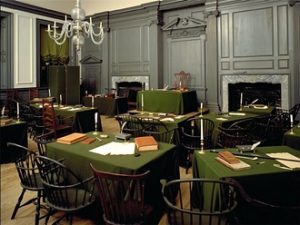
1787 – With George Washington presiding, the Constitutional Convention formally convened in Philadelphia. The convention faced a daunting task: the peaceful overthrow of the new American government as it had been defined by the Article of Confederation.
The process began with the proposal of James Madison’s Virginia Plan which strongly resembled Britain’s parliament. It featured a bicameral legislature, with representation in both houses apportioned to states based upon population. The two houses would in turn elect the executive and the judiciary and would possess veto power over the state legislatures.
William Patterson of New Jersey proposed a plan more attractive to the new nation’s smaller states. Each state would have a single vote in Congress as it had been under the Articles of Confederation, to even out power between large and small states. But, the plan also gave Congress new powers: the collection of import duties and a stamp tax, the regulation of trade and the enforcement of requisitions upon the states with military force.
Alexander Hamilton of New York put forward to the delegates a third plan, a perfect copy of the British Constitution including an upper house and legislature that would serve on “good behavior”.
Confronted by the three counter-revolutionary options, Roger Sherman of Connecticut finally came up with a workable compromise: a government with an upper house made up of equal numbers of delegates from each state and a lower house with proportional representation based upon population. This idea formed the basis of the new U.S. Constitution, which became the law of the land in 1789.
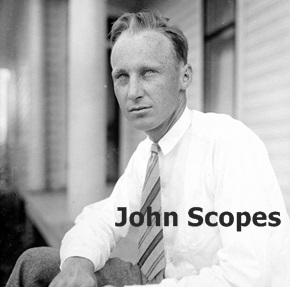
1925 – Settle in, this one is going to take a while …
John Thomas Scopes was indicted on charges of having taught from a chapter on evolution in George William Hunter’s textbook, Civic Biology: Presented in Problems to a Dayton, Tennessee high-school class in violation of the state’s Butler Act, which had made it unlawful to teach human evolution in any state-funded school.
The film, Inherit The Wind drew its premise from the Scopes “Monkey” Trial but should not be relied upon as a historical document. Much of the movie was fictional with numerous instances where events and characters were substantially altered or invented.
The Scopes Trial had its actual origins in a conspiracy created by George Rappalyea, a local coal company manager who argued to other town leaders that a trial would be a way of putting Dayton on the map. The population had fallen from 3,000 in the 1890’s to 1,800 in 1925.
Rappleyea pointed out that while the Butler Act prohibited the teaching of the theory of evolution, the state required teachers to use a textbook that explicitly described and endorsed the theory of evolution, and that teachers were, therefore, effectively required to break the law.
Scopes mentioned that while he couldn’t remember whether he had actually taught evolution in class, he had, however, gone through the evolution chart and chapter with the class. Scopes added to the group: “If you can prove that I’ve taught evolution and that I can qualify as a defendant, then I’ll be willing to stand trial.”
A carnival atmosphere pervaded Dayton as the trial began in July of 1925. Banners decorated the streets. Lemonade stands were set up. Chimpanzees, said to have been brought to town to testify for the prosecution, performed in a side show on Main Street. Anti-Evolution League members sold copies of T. T. Martin’s book Hell and The High School.
Nearly a thousand people, 300 of whom were standing, jammed the Rhea County Courthouse on July 10, 1925 for the first day of trial. Judge John T. Raulston, the presiding judge in the Scopes Trial, had proposed moving the trial under a tent that would have seated 20,000 people. Also in attendance were announcers ready to send to listeners the first live radio broadcast from a trial.
When the sideshow trial ended, famed defense attorney Clarence Darrow asked the jury to return a verdict of guilty in order that the case might be appealed to the Tennessee Supreme Court. Under Tennessee law, special prosecutor William Jennings Bryan was thereby denied the opportunity to deliver a closing speech he had labored over for weeks. The jury complied with Darrow’s request, and Judge Raulston fined him $100.
A year later, the Tennessee Supreme Court reversed the decision of the Dayton court on a technicality – not the constitutional grounds as Darrow had hoped. According to the court, the fine should have been set by the jury, not Raulston. Rather than send the case back for further action, however, the Tennessee Supreme Court dismissed the case. The court commented, “Nothing is to be gained by prolonging the life of this bizarre case.”

1935 – Babe Ruth – playing with the Boston Braves after fifteen remarkable years with the New York Yankees – was struggling at the plate. Yet for one more afternoon, Ruth turned back the clock in Pittsburgh. On this date, the Sultan of Swat gave fans one final show.
Sitting on 711 career home runs, Ruth swatted three on this day, including the 714th and final home run of his storied career. The last homer sailed out of the park over the right field upper deck – the first time anyone had hit a fair ball completely out of Forbes Field. Ruth, then 40 and experiencing the worst season in his career (he was hitting just .181) retired one week later.
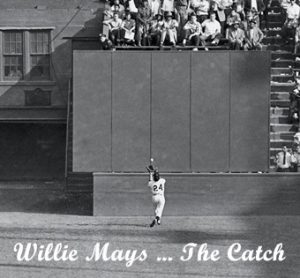
1951 – Willie Mays made his Major League debut with the New York Giants. Although he went hitless in his first 12 plate appearances, he went on to win Rookie of The Year and compiled astonishing numbers in his prolific career: 3,283 hits, 660 home runs, 1,903 RBI, 338 stolen bases, 24-time All Star, 2-time National League MVP, and of course, an inductee into the Baseball Hall of Fame.
The photo above shows what many believe is the greatest catch in baseball history. With the game tied 2–2 in the eighth inning of Game 1 of the 1954 World Series, the Cleveland Indians had runners on first and second against the Giants. Cleveland’s Vic Wertz hit a 425-foot shot to center field, and Mays sprinted towards the wall to track it down. He caught it over his shoulder, turned and gunned it back towards the infield, preventing the runs from scoring.
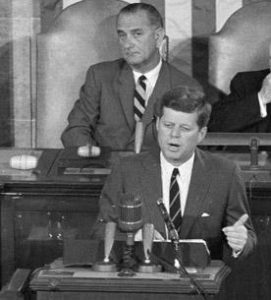
1961 – President John F. Kennedy announced to Congress his goal of sending an American to the moon by the end of the decade and asked for financial support of an accelerated space program. He made the task a national priority and a mission in which all Americans would share, stating that it would not be one man going to the moon; it would be an entire nation.
Kennedy linked the need for a space program with the political and economic battle between democracy and communism. He urged Congress to mobilize financial resources to speed up the pace of the space program’s progress, insisting that America should go into space because whatever mankind must undertake, free men must fully share.
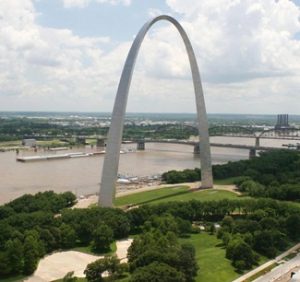
1968 – The Gateway Arch, a 630-foot monument in St. Louis, Missouri, was formally dedicated. It is the world’s tallest arch, the tallest man-made monument in the Western Hemisphere, and Missouri’s tallest accessible building.
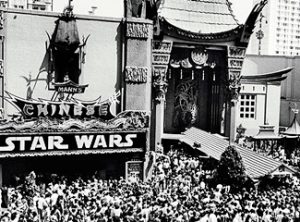
1977 – 20th Century Fox premiered George Lucas’ space odyssey Star Wars at Mann’s Chinese Theatre in Hollywood. Expectations weren’t very high. Worried that Star Wars would be beaten out by other summer films, such as (and this is no joke) Smokey and The Bandit, the studio moved the release date to the Wednesday before Memorial Day.
Fewer than 40 theaters ordered the film to be shown that first weekend, but within three months, the film was playing in 1,096 theaters in the United States.
Filmed on a budget of $11 million, the movie has generated over $800 million at the box office and is credited with reviving the science-fiction film genre, which had previously been considered highly unprofitable.
In addition to its commercial success, Star Wars was well received by critics and was nominated for 10 Academy Awards, including Best Picture. It won in six categories, mostly technical, and received an additional Oscar for Special Achievement in Sound Editing.
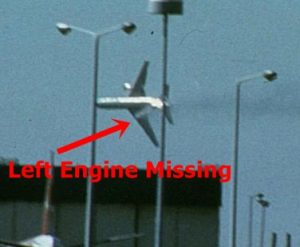
1979 – American Airlines Flight 191 crashed and exploded after losing one engine just after taking off from Chicago’s O’Hare Airport, bound for Los Angeles.
The DC-10 jet appeared to take off normally but after rising to only 400 feet, stalled and then rolled to the left. The plane quickly plunged, crashing into Ravenswood Airport, which had been abandoned and was no longer in use.
The plane, loaded with fuel, exploded on impact, killing all 277 people on board instantly. The heat from the fire was so intense that firefighters could not approach the crash for close to an hour. The crash also caused a fire at a nearby mobile-home park and killed two bystanders on the ground.
As the plane accelerated during its takeoff roll, the left engine (engine #1) ripped free of its mount under the wing (as shown in the photo above). The engine was at full thrust at the time. This pushed the engine forward of the wing where the wind velocity then caught the engine and flipped it back up and over the left wing, where it landed in the runway. The pilots were aware that engine #1 was no longer available, but not that it was no longer attached to the aircraft. Since they had achieved takeoff speed, they could no longer safely abort.
The National Transportation Safety Board found that American Airlines mechanics had taken a shortcut in removing the engines from the plane’s wing pylons (which support the engine) for maintenance. That mistake two months before the crash had cracked an aluminum component in the pylon. Wear and tear widened the crack until the piece broke, and as the engine tore loose, it damaged electrical and hydraulic systems, a combination that left the plane unable to fly.
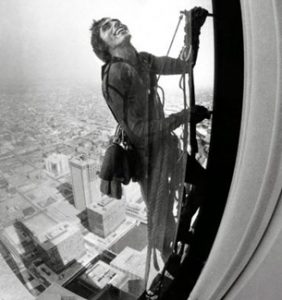
1981 – Daredevil Dan Goodwin, wearing a Spider-Man suit and using suction cups, camming devices, and skyhooks, successfully scaled the then-tallest building in the world, the 110-story Sears Tower in Chicago. For seven hours, Goodwin fought the high altitude winds, slippery glass, and repeated attempts by the Chicago Fire Department to stop him.
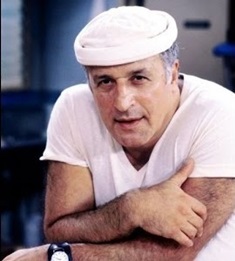
1990 – Actor Vic Tayback died of a heart attack at the age of 60. Tayback appeared in over 40 movies and made numerous guest appearances as a character actor on television during his career.
He is best remembered as diner owner Mel Sharples in both the movie Alice Doesn’t Live Here Anymore and the television series, Alice, which ran from 1976 to 1985. He was the only actor in the original film to reprise his role in the series.
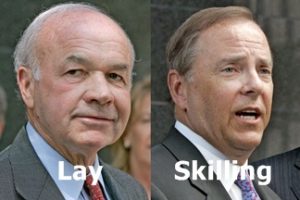
2006 – Former Enron Corp. chiefs Kenneth Lay and Jeffrey Skilling were convicted in Houston of conspiracy and fraud for the company’s downfall. Lay died from a heart attack two months later (before his scheduled sentencing). On October 17, 2006 his conviction was overturned due to abatement ab initio, a legal doctrine which says the death of a defendant during an appeal vacates the conviction.
Skilling was sentenced to 24 years in prison, and fined $45 million. He is scheduled for release on February 21, 2019.
Compiled by Ray Lemire ©2018 RayLemire.com. / Streamingoldies.com. All Rights Reserved.
Not only did I learn/relearn some history, but I learned a new word-bicameral(had to look it up in the dictionary!)
You get extra credit for following up! 🙂